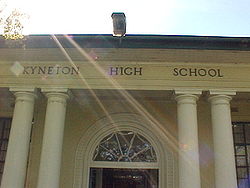
Kyneton Secondary College
Encyclopedia

Secondary school
Secondary school is a term used to describe an educational institution where the final stage of schooling, known as secondary education and usually compulsory up to a specified age, takes place...
in Kyneton
Kyneton, Victoria
Kyneton is a town on the Calder Highway in the Macedon Ranges of Victoria, Australia. The Calder Freeway bypasses Kyneton to the north and east. The town was named after the English village of Kineton, Warwickshire. The town has three main streets: Mollison Street, Piper Street and High Street...
, Victoria, Australia
Australia
Australia , officially the Commonwealth of Australia, is a country in the Southern Hemisphere comprising the mainland of the Australian continent, the island of Tasmania, and numerous smaller islands in the Indian and Pacific Oceans. It is the world's sixth-largest country by total area...
, approximately 90 km north of Melbourne
Melbourne
Melbourne is the capital and most populous city in the state of Victoria, and the second most populous city in Australia. The Melbourne City Centre is the hub of the greater metropolitan area and the Census statistical division—of which "Melbourne" is the common name. As of June 2009, the greater...
. It was built in 1912, and opened in 1928 under the name of Kyneton High School.
History of the College
In 1966 a technical component was added to the school and it became known as Kyneton Technical-High School.In 1985, a Vertical Unit Structure was introduced in Years 8-10, STC and Group 2 subjects were offered to Year 12 students along with Group 1 subjects and Year 11 courses became semester length.
In 1989 the Junior Complex was opened and in 1991 the second stage of the building program was completed, which included the Boomerang, Textiles, Art and Home Economics buildings.
Year 8 returned to a horizontal structure in 1992, with Years 9 and 10 returning to a partly horizontal structure in 1993.
Kyneton Secondary College became a ‘School of the Future’ in 1995.
In 1996 the V.U S. was replaced with a horizontal approach to curriculum delivery incorporating
Enrichment and Extension Electives and providing the opportunity for Year 10 students to study VCE Geography or Information Technology.
In 1998 Vocational Education subjects were introduced at Year 11. In 1999 the Table Small Groups cooperative learning approach was introduced at Year 7 with teacher teams and was extended to Year 8 in 2000. In 2002, the range of VCE units available at Year 10 was increased and extension electives incorporated with general electives. All year 10 blocks were aligned with VCE blocks in 2004 thus allowing greater flexibility for students in year 10 to do VCE subjects. The new Victorian Certificate of Applied Learning (VCAL) was introduced in Year 11 in 2003 and was extended to Year 12 in 2004. In 2007 an Applied Learning Program will be introduced a t Year 10.
The Victorian Essential Learning Standards (VELS) was progressively implemented in 2007 for years 7 to 10.

